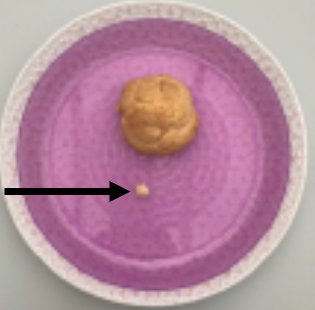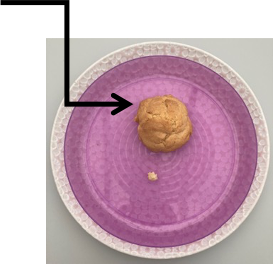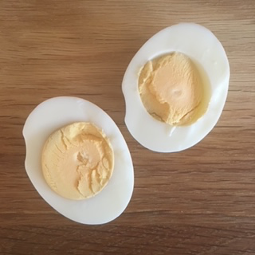Mini Apple Cakes – makes 8
|
Ingredients |
Method |
|
|
1 medium egg (beaten) 100g apple puree (jar/pouch) or 25g sugar 50g vegetable oil 80g plain flour 1 level tsp baking powder |
|
|

The onset of egg allergy is usually seen early in life especially in children with eczema. In the UK 2% of children will have developed an egg allergy by 2 years of age. It commonly presents after children eat egg for the first time. Most reactions occur to lightly cooked egg such as scrambled egg, with reactions to baked egg being less common. Egg allergy resolves spontaneously in many affected children over several years.
You have been given this factsheet as your child has previously reacted to egg. It will help you reintroduce egg to your child’s diet. It explains how to do this safely at home. Children with an egg allergy often tolerate baked egg. Baked egg is egg that is used as an ingredient in food alongside flour that is cooked in the oven. An example of baked egg is cake. Eating baked egg on a regular basis may help your child to grow out of their egg allergy.
Mini Apple Cakes – makes 8
|
Ingredients |
Method |
|
|
1 medium egg (beaten) 100g apple puree (jar/pouch) or 25g sugar 50g vegetable oil 80g plain flour 1 level tsp baking powder |
|
|
1. Give your child a pea-sized piece of cake to eat (see example in the image). You should then watch your child for symptoms for the next two hours.

2. If no symptoms appear, the next day, give your child another piece of cake that is twice the size
3. Watch your child again for symptoms for two hours.
4. Continue doubling the amount of cake on a daily basis until one mini apple cake has been eaten. This should take about seven days.
What if my child won’t eat cake?
If your child dislikes the taste or texture of cake there are a few alternatives to try:
The following recipes can be used instead of cake in the same quantity given for the cake under step 2 above.
Sweet or Savoury Pancake sheet – makes 1 sheet to be cut into 8 portions
|
Ingredients |
Method |
|
1 medium egg (beaten) 200g self-raising flour. 1 tsp baking powder. 250ml milk 100g preferred chopped/grated fruit or vegetable that is already eaten in the diet such as raspberries, blackberries or roasted peppers.
|
|
Banana Cookies - makes 8 toddler size cookies
|
Ingredients |
Method |
|
1 medium egg (beaten) 1 large ripe banana, mashed 75g dairy free margarine 140g plain flour 1 level tsp baking powder ½ tsp vanilla extract (optional) 40g raisins
|
|
Potato Rosti - makes 8 rosti
|
Ingredients |
Method |
|
1 large (200 – 250g) White potato, peeled 1 carrot, peeled 1 onion, peeled 75g plain flour 1 medium egg (beaten) 1tsp Dried Thyme or parsley (optional) Oil or oil spray (optional) |
|
What if my child has an allergic reaction?
You should have been given an Allergy Action Plan showing you how to recognise the symptoms of an allergic reaction. Have antihistamine syrup available in case of a minor allergic reaction. Examples include Chlorphenamine (Piriton) or Cetirizine (Piriteze). Let your doctor, dietitian or allergy nurse know if your child has a reaction. Do not give your child any more baked egg.
Once your child is managing baked egg 2-3 times a week the amount of egg added to the recipes given can be increased. This can be done by simply increasing the number of eggs in the recipes above from 1egg to 2eggs. The way the food is given is as previously described:

If your child is managing one mini apple cake or a portion of food from the alternative recipes above, then baked egg can become a regular part of your child’s diet. Aim to include baked egg in the diet at least 2-3 times a week. Below are some shop bought ideas that could also be used if they contain egg:
Once your child has been eating baked egg at least 2-3 times a week for around 6 months it’s time to try them with egg that has been cooked in other ways. This may be boiled or scrambled. This is called well-cooked egg. They should continue to have the baked egg in the diet as well. It is best to start with well-cooked hard-boiled egg.

Boil a medium sized egg in a saucepan of boiling water for at least 10 minutes. Both the white and the yolk should be well cooked. How you feed your child the egg will depend on their age. Below is the suggested way of doing it.
Only introduce well-cooked hard-boiled egg into your child’s diet when your child is well.
Hard-boiled egg has a strong taste so it can be added to other foods or made into a sandwich. If your child enjoys the taste and is age appropriate, slices of hard-boiled egg can be given as a finger food or picky meal.
Once your child can tolerate well-cooked hard-boiled egg other forms of cooked egg can be offered such as a well-cooked scrambled egg or omelette. Repeat step 2 above using well-cooked scrambled egg made with one egg.
Once hard-boiled and scrambled egg is tolerated other foods containing cooked egg can be eaten. Below are some examples of products containing cooked egg.
Once cooked egg is tolerated, patients should be reassured that egg allergy is outgrown and egg should be included as part of the normal diet. If there is a reaction, then the previously tolerated egg should be eaten, and further reintroduction considered after 3–6 months.
How to introduce raw or less well cooked egg at home
Below are some examples of products containing less well cooked or raw egg. They can be introduced gradually after well-cooked egg has been eaten regularly for 6 months. This is the form of egg your child is likely to grow out of last. Start by giving one small mouthful such as a lick of an egg containing ice cream or a teaspoon of mousse. Slowly increase the amount offered each time.
Foods that commonly contain egg
Baked egg |
Well-cooked egg |
Raw egg |
|
Plain cakes, sponge fingers, brioche, croissants, biscuits & cookies – remember no icing that contains egg
Dried egg pasta and noodles Egg in shop bought sausages, meatballs, gravy granules and gluten free bread
Egg glaze on pastry
Quorn products
Sheet pancake
Shop bought precooked frozen Yorkshire puddings or ready-made pancakes and scotch pancakes |
Boiled egg
Fried egg
Omelette
Poached egg
Scrambled egg
Quiche
Batter made with egg
Egg custard
Bread and butter pudding
Fresh egg pasta
Pancake cooked in frying pan
Meringue |
‘Dippy’ uncooked boiled, fried or poached egg
Mousse
Mayonnaise
Ice cream especially fresh and luxury types
Freshly made sorbet
Royal icing (fresh and powdered icing sugar) & soft mallow
Fondant icing inside a Cadbury’s crème egg®
Raw egg in cake mix and other dishes waiting to be cooked (children of all ages love to taste!)
Carbonara sauce, Tartar sauce
Chocolate bars containing egg in their filling eg Milky way®, Mars bar® |